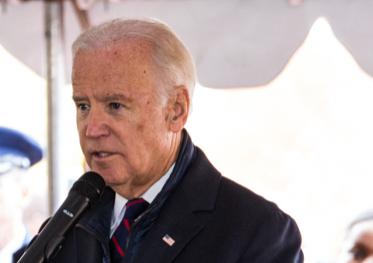Constitution
Sorry President Biden, But Nobody Wants a Glorified Golf Cart
The Biden administration’s push for electric vehicles has hit the wall of rejection, so they want to make them the law.,

President Biden in 2021 drove a Ford F-150 Lightning and expressed his desire to electrify the White House’s fleet of vehicles, including the armored presidential limo known as “the Beast.”
At the time, Bryan Hood doubted the wisdom, given its weight of 15,000 to 20,000 pounds, its armor and high-tech security features, and its oversized truck frame. At twice the weight of the GMC Hummer EV, the Beast would require a massive battery array to provide any real protection – and would be defenseless in the event of a battery failure.
In his first week in office, President Biden announced his goal of electrifying the entire 600,000-vehicle federal fleet of civilian vehicles, to be “made right here in America.” He pledged, “I’m going to start the process where every vehicle in the U.S. military is going to be climate friendly.”
Biden’s goal, reiterated last April by Energy Secretary Jennifer Granholm, is to electrify all U.S. military vehicles, including tanks and aircraft, by 2030, a daunting, budget-busting task. The Army’s 242,000 tactical vehicles should for now be hybrids, but its 170,000 non-tactical cars and trucks “could go right to electric,” according to Deputy Defense Secretary Kathleen Hicks.
Biden even envisions electric tanks, which Kyle Mizokami, writing in Popular Mechanics, says makes a lot of sense. In his view, EV tanks reduce the vulnerability of fuel-laden convoys; are more easily upgraded than tanks with internal combustion engines and transmissions; and are cheaper to run and “easier on the planet.”
After all, the chief goal, says Mizokami, is “to get away from fossil fuels,” not to win wars.
One obstacle to the Biden Administration’s goal was the adoption in 2021 of a new postal vehicle design, to be built by Wisconsin-based Oshkosh, that can be fitted with both gasoline and electric drive trains. The award dealt a heavy blow to the favored all-electric contractor, Workhorse.
Recent reports indicate that only about 2 million fully electric vehicles have been sold in the United States, two-thirds of them Teslas. Total electrification for federal vehicles alone could match that number – at enormous, budget-busting cost.
The EV merchants, however, have been rocked of late by some very bad news. Most Americans appear unwilling to adapt to a plug-in future. Like Mad Max, they queue up at the pump saying, “I’m just here for the gasoline.”
Ford just announced it was cutting production of Biden’s beloved F-150 Lightning pickups in half, to just 1,600 vehicles per week, for 2024. This on the heels of cutting the price by $10,000, despite the fact that the storied automaker was already losing $66,000 for every electric vehicle that comes off its assembly lines.
General Motors is pushing back the opening of an electric truck factory in Detroit after scrapping an earlier goal of producing 400,000 EVs over a two-year period through 2024. The automaker may be dropping its Buick line to stay afloat.
Was Biden’s plan to drive all U.S. auto makers into bankruptcy?
Then there’s the report that investors are backing off from EV charging companies. Stock prices have fallen at ChargePoint, EVgo, and Blink Charging in spite of Biden’s $7.5 billion in subsidies. Blink Charging CEO Brendan Jones told The Wall Street Journal, “I think the investor class has grown weary of the industry’s lack of profitability.”
And no wonder.
Back in February Biden praised ChargePoint, which operates the nation’s largest public network of EV charging stations, for demonstrating that his efforts had “spurred network operators to accelerate the buildout of coast-to-coast EV charging networks.”
Oops!
ChargePoint’s stock value had dropped from a high of $46.10 per share in December 2020 to just $2.24 per share in December 2023, down nearly 75% in this year alone. CEO Pasquale Romano has stepped down, and the company is facing a class action lawsuit. Plaintiffs claim the firm’s share price was artificially inflated because of false and misleading statements by company executives.
Biden’s dream of an all-electric vehicle fleet is further compounded by an April 2023 Gallup Poll that showed only 12% of American auto buyers (and just 1% of GOP voters) were “seriously considering” purchasing an EV.
In Europe, where most new vehicles are sold via lease, the rapidly declining value of used EVs is causing rental car firms and other fleet purchasers to cut back on EV adoptions that end up costing money on the back end.
Chinese motorists have purchased an estimated 14 million EVs, but today its used car lots are overflowing with unsold vehicles, and junkyards brim with abandoned EVs with plants sprouting from their trunks.
Add the significantly lower resale value of used EVs to the list of reasons motorists are resisting state and federal lawmakers and regulators and other EV enthusiasts who demand submission without any questions.
The Biden Administration has spent trillions to jumpstart a (heavily subsidized) EV “market.” Several states have followed California’s lead to forbid the sale of non-electric vehicles. New Jersey’s ban begins in 2035, but Rhode Island and Washington upped the ante to 2030.
That’s earlier than the 2040 date set at COP 26 in Glasgow and adopted by dozens of countries from Canada to Azerbaijan (host to COP 29). Curiously, some commentators see the 2040 deadline as a “weak and unambitious goal.”
Electrek’s Fred Lambert believes “there will be a major shift in consumer demand around 2024-25 that will result in virtually all new car buyers realizing that their next car is going to have to be electric.”
And that’s the key – HAVE TO BE ELECTRIC.
The UN, the Biden White House, the myriad states that have adopted EV-only mandates, and numerous Al Gore and John Kerry wanna-be’s have decided that the world’s 1.4 billion motor vehicle owners, most of whom have voted with their mouths and their pocketbooks that they do not trust electric vehicles, can have no say in how they spend their hard-earned money.
Prior clashes between autocratic governments and noncompliant masses have not turned out well. In the world of Mad Max, governments lose all control over the population and collapse, leading to the collapse of civilized society and a return to a nomadic search for, well, gasoline.
Today, there remains the possibility of voting out those who intend to impose an all-electric future on unwilling people – despite the gargantuan efforts of those in control to prevent such a political uprising.
In the U.S., 2024 will mark a major turning point. Those who still prefer their gas appliances, gasoline-powered vehicles, rare steaks, and innumerable other benefits of modern society need to recognize that this may be the last time they have a chance to keep those choices available in the future.
Otherwise, Fred Lambert may be right. People will tuck their tails, bow their heads, and submit their entire lives to the whims of a few self-righteous billionaires and their greedy lieutenants.
Meanwhile, the bullies still insist that we drive electric golf carts whether we like it or not.
This article was originally published by RealClearEnergy and made available via RealClearWire.
Duggan Flanakin is a senior policy analyst at the Committee For A Constructive Tomorrow who writes on a wide variety of public policy issues.
-

 Civilization4 days ago
Civilization4 days agoDC Pipe Bomb Arrest Raises Questions About Christopher’s Wray’s FBI
-

 Civilization5 days ago
Civilization5 days agoThe Legal Logic Behind U.S. Operations Against Narco-Terrorist Networks
-

 Executive5 days ago
Executive5 days agoNewsom’s ‘National Model’ for Homeless Wracked by Fraud
-

 Executive4 days ago
Executive4 days agoWhen You’re in a Hole, Stop Digging
-

 Education3 days ago
Education3 days agoWaste of the Day: Taxpayers Subsidize Football Coach Severance
-

 Executive2 days ago
Executive2 days agoWaste of the Day: Obamacare Failed Test, Approved Fraudulent Subsidies
-

 Civilization3 days ago
Civilization3 days agoPence Calls on Trump To Fire RFK Jr Over Abortion Drug
-

 Civilization3 days ago
Civilization3 days agoRight-Wing Antisemitism, Liberalism, and Leo Strauss








